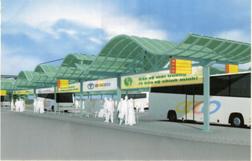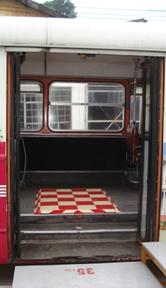 Hanoi is not very friendly for pedestrians. Very often it is difficult and even dangerous to go to the bus stop and get into the bus. Particularly for handicapped people, for the old and for pregnant women, there are problems. Hanoi is not very friendly for pedestrians. Very often it is difficult and even dangerous to go to the bus stop and get into the bus. Particularly for handicapped people, for the old and for pregnant women, there are problems.
The Institue für Verkehrswirtschaft of the University Hannover prepared for ECOTRANS a study „Bus Stop Access along the Dyke Road Hanoi“, analyzing the situation and making the design for improved location and access for the bus stops.
The ECOTRANS team prepared plans for a model line between Gia Lam and My Dinh, as well as for the Nguyen Trai Corridor.
The principals of the design are:
• Stations in the two directions should face oneanother,
• They must be connected by a protected pedestrian crossing,
• The bus must be able to stop very close to a raised sidewalk – no gap!
• A bicycle path should be behind the station, so that the bus does not run over or cross the course ob bicycles. Bikers are mostly children and the urban poor.They need protection.
As we do not propose to introduce low floor busses, but only semi low floor, the floor hieght of 60 cm can be reached from a sidewalk which is raised to 35 cm. This means the platform of the bus is only 15 cm higher than the normal sidewalk. A gentle slope makesthe platform accessible without disrupting the sidewalk. Boarding is just one step, which is comfortable. Handicapped can enter using a ramp, built into the bus.
Case study: improve bus stop access on the dyke road corridor
Tran Nhat Duat - Tran Quang Khai – Tran Khanh Du roads (Hanoi dyke road) have been chosen as it is a transit axis also serving a very populated area. Pedestrian crossing is particularly difficult here as the two circulation directions are separated by fences and a level difference.
 
Difficulties to cross the road
The study has been realized by IVH institute (Institute of Transport, road engineering and Planning) from Hanover University. Its propositions focus on:
→ Specific installation for each mode of transport (bicycle lanes, bus stops),
→ Pedestrian crossings,
→ Installation of park and ride for bicycles and motorbikes,

Proposition of bus center lane

Side lane bus stop and bicycle installation
Installing a bus interchange station
Travelling around in town, the passenger needs often to change the bus line. Of course interchange is possible, but very often, this is the most dangerous part of the journey. Already under ASIATRANS a first comfortable modern interchange has been built. Under ECOTRANS, one of the most frequented and at the same time most dangerous interchanges has been redesigned: Long Bien. Construction should start in November 2007, completion latest by March 2008.
The principal of an interchange is, that different lines stop along the same platform. The platform in the opposite direction can be reached simply by crossing the bus lane. In order to protect the interchange from all forms of other traffic, the interchange stations is best placed in the center of the road. Protected pedestrian access, usable also for handicapped are of course provided.
Long Bien has been chosen as it is a symbolic place (at one end of the famous Eiffel bridge, near the night market and the train station), it is served by 19 bus lines and the needs are high as the place is highly disorganized (bus shelters far from each other and not attractive, almost no pedestrian crossings, chaotic traffic…).
 
The 3 main orientations are:
- Solve traffic problems by creating a big roundabout which will decrease the number of conflict points.
- Create a bus interchange station which is adapted to the existing situation and compatible with future projects that may take place in this sector (BRT, metro).
Including 3 platforms and 4 stopping zone it has a capacity of 300 bus/h and several thousands of passengers.
All installations are accessible by handicapped persons

General traffic organization, in orange is the bus interchange
- Landscape upgrading: shelters and public spaces have been specially designed by a French architect in order to give back a good image to a degraded site
 
Handicapped accessibility actions
A study has been realized to evaluate the feasibility of making accessible to the handicapped one line of Hanoi’s bus network. Line chosen is line 34 as having adapted buses (low floor and wide doors) and an urban route fitting well with potential handicapped needs.
Result of the study show that adapting one line is possible and not too costly in Hanoi’s condition provided adapted buses are available.
In the case of the Renault bus (used in line 34) adaptation consists of:
- Remove the handle bar in the middle of the center door
- Install a special removable ramp (a prototype has been build by experts of Hanoi EcoTrans) to allow wheel chair user to get easily from the sidewalk to the bus.
 
The 120cm ramp can easily be taken out and it by the ticket seller when a handicapped person demand it.
It can be installed in 2 type of bus used in Hanoi: the Renault SC10 and the Tanda China
Cost is very low: around 1 600 000 VND (70euros) per unit.
Adaptation of the side walk should also be realized as follow:
- Elevating the sidewalk to reduce the slope of the ramp.

- The sidewalk is separated in 2 different zones which could be separated by a barrier or poles:
+ The elevated area (in red) is a bus stop place,
+ The rest of the sidewalk (in yellow) is a transit place



- Installation of a special kerbstone to allow the bus to approach the maximum possible the sidewalk
Other studies concerning bus stop access
Other small scale studies concerning bus stop access have been realized by the study center on Tramoc request:
· Dedicated lanes for buses on Nguyen Trai street (national road no 6):
The proposed solution consists of bus center lane which is the best solution in term of bus operation efficiency and traffic safety for all the modes of transport
Schematic of installation proposed in Nguyen Trai

The problem of pedestrian crossings is solved by using existing traffic light or slowdown strips
Hanoi railway station:
A study including propositions for bus, taxis, private car and motorbike taxi operation and public space improvement has been realized.
2 options are proposed:
 
Bus operation to the north Bus operation to the south
Cua Nam intersection:
Cua Nam intersection is on of the most complex in the city: it includes six roads and 3 bus stops. Proposition is to install center lane bus stop.

Center lane is the most efficient solution for bus operation
|